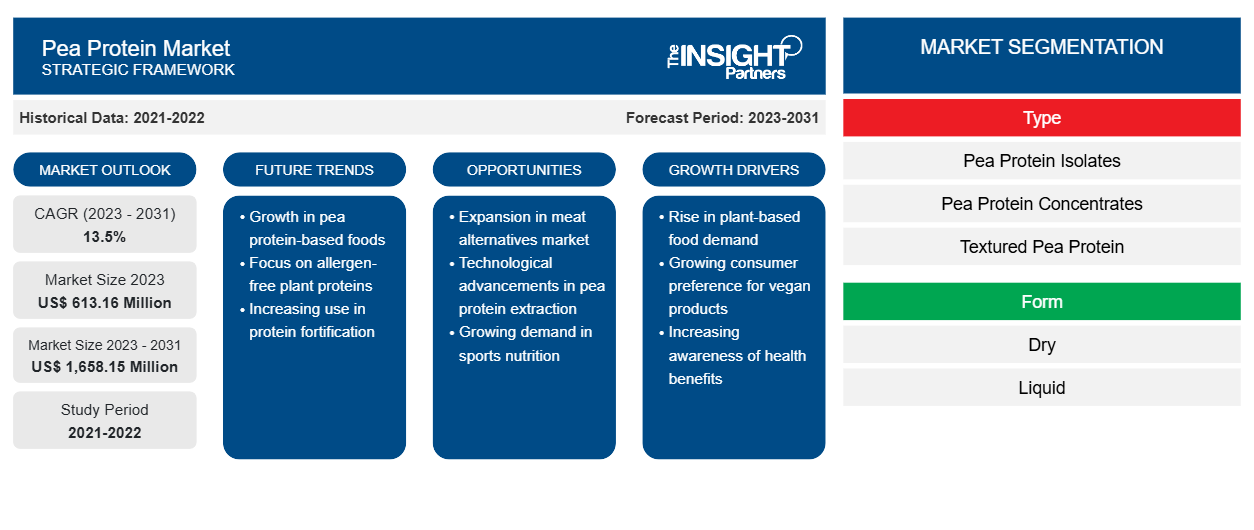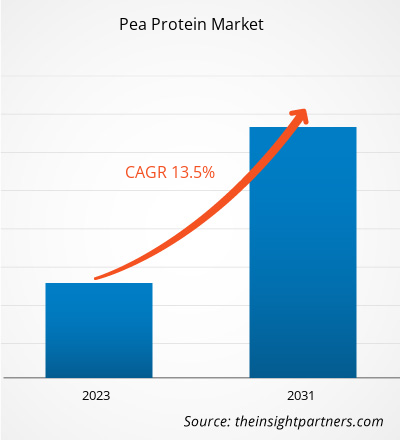Pea Protein Market Dynamics and Developments by 2031
Historic Data: 2021-2022 | Base Year: 2023 | Forecast Period: 2023-2031Pea Protein Market Size and Forecast (2021–2031), Global and Regional Share, Trend, and Growth Opportunity Analysis Report Coverage: By Type (Pea Protein Isolates, Pea Protein Concentrates, Textured Pea Protein); Form (Dry, Liquid); Application (Dietary Supplements, Bakery and Confectionery Goods, Meat Alternatives, Beverages, Others), and Geography
- Report Date : Feb 2026
- Report Code : TIPRE00003891
- Category : Food and Beverages
- Status : Data Released
- Available Report Formats :


- No. of Pages : 150
The Pea Protein Market size is projected to reach US$ 1,658.15 million by 2031 from US$ 613.16 million in 2023. The market is expected to register a CAGR of 13.5% in 2023–2031. Glowing sales of pea protein as protein source in pet food and animal feed are likely to remain key pea protein Market trends.
Pea Protein Market Analysis
The pea protein market is growing at a significant rate owing to factors such as enhanced health consciousness, multiple health benefits, and increased demand for meat protein alternatives. In addition, factors, such as the trend of living using pea protein in various products, consistent increase in food & beverages industries, raised demand for organic-based foods, and innovations in protein-based products, have supplemented the global pea protein market growth. The growing number of consumers searching for simpler labels, great taste, and alternative protein sources to solve personalized nutrition choices which in turn may accelerate pea protein market growth. However, the availability of substitute proteins and low consumer awareness about the pea protein-based products may restrict the growth of the market over the forecast period.
Pea Protein Market Overview
Pea protein is obtained from green and yellow split peas and is mostly used to make protein powder. It often serves as a base in packaged foods like veggie burgers, vegan mayo, and even replaces dairy in some ice creams and milk. Pea protein is an excellent source of iron. It is added in food products such as smoothies and shakes to increase the protein content and is also a great fit for almost any diet since it's naturally vegan and hypoallergenic. Pea protein contains nine essential amino acids that the human body cannot create.
Customize This Report To Suit Your Requirement
You will get customization on any report - free of charge - including parts of this report, or country-level analysis, Excel Data pack, as well as avail great offers and discounts for start-ups & universities
Pea Protein Market: Strategic Insights

-
Get Top Key Market Trends of this report.This FREE sample will include data analysis, ranging from market trends to estimates and forecasts.
Pea Protein Market Drivers and Opportunities
Increasing Demand for Dietary Supplement to Favor Market
Pea protein is used in nutraceuticals such as dietary and health supplements, and for digestive health. A dietary supplement is consumed orally either as a tablet, capsule, pill, or a liquid. Dietary supplements are food products that contain mineral, vitamin, herb or other botanicals, or amino acids. Pea proteins are induced in dietary supplements so that they can provide an external source of vitamins, minerals, fibers and other essential ingredients to the consumer. Growing demand of these dietary supplements among the consumers have driven the growth of the market.
Growing Demand for Pea-Protein Based Sport Nutrition and other Wellness Products
Pea protein various functional properties emulsification, texture enhancement, and foaming has widened its market potential. Key players in the market are taking initiatives to develop products using pea protein, to cater the consumer demand.
Pea Protein Market Report Segmentation Analysis
Key segments that contributed to the derivation of the Pea Protein Market analysis are type, form and application.
- Based on type, the pea protein market is segmented into pea protein isolates, pea protein concentrates, textured pea protein.
- By form, the market is bifurcated into dry and liquid.
- In terms of application, the market is segmented into dietary supplements, bakery and confectionery goods, meat alternatives, beverages, and others.
Pea Protein Market Share Analysis by Geography
The geographic scope of the pea protein market report is mainly divided into five regions: North America, Asia Pacific, Europe, Middle East & Africa, and South America/South & Central America.
North America has dominated the pea protein market. The growing interest of consumers in non-meat alternatives as a result of increasing concerns towards a healthy lifestyle has enabled the manufacturers in North America to incorporate high-quality plant-based ingredients. An increase in matters regarding the environment and an upsurge in awareness towards animal welfare has shifted the focus towards alternative proteins derived from plant-based proteins. Asia Pacific is anticipated to grow with the highest CAGR in the coming years.
Pea Protein Market Regional Insights
The regional trends and factors influencing the Pea Protein Market throughout the forecast period have been thoroughly explained by the analysts at The Insight Partners. This section also discusses Pea Protein Market segments and geography across North America, Europe, Asia Pacific, Middle East and Africa, and South and Central America.
Pea Protein Market Report Scope
| Report Attribute | Details |
|---|---|
| Market size in 2023 | US$ 613.16 Million |
| Market Size by 2031 | US$ 1,658.15 Million |
| Global CAGR (2023 - 2031) | 13.5% |
| Historical Data | 2021-2022 |
| Forecast period | 2023-2031 |
| Segments Covered |
By Type
|
| Regions and Countries Covered |
North America
|
| Market leaders and key company profiles |
|
Pea Protein Market Players Density: Understanding Its Impact on Business Dynamics
The Pea Protein Market is growing rapidly, driven by increasing end-user demand due to factors such as evolving consumer preferences, technological advancements, and greater awareness of the product's benefits. As demand rises, businesses are expanding their offerings, innovating to meet consumer needs, and capitalizing on emerging trends, which further fuels market growth.

- Get the Pea Protein Market top key players overview
Pea Protein Market News and Recent Developments
The pea protein Market is evaluated by gathering qualitative and quantitative data post primary and secondary research, which includes important corporate publications, association data, and databases. The following is a list of developments in the market for speech and language disorders and strategies:
- In January 2023, Burcon NutraScience Corporation, a global technology leader in the development of plant-based proteins for foods and beverages, is pleased to announce that it has received a notice of allowance from the United States Patent and Trademark Office (“USPTO”) for a patent application covering characteristics of Burcon’s Peazazz® pea protein made by Burcon’s unique process. A notice of allowance from the USPTO is a written notification that a patent application has cleared internal review, is pending issuance and will grant in the near future. (Source: Burcon NutraScience Corporation, Press Release/Company Website/Newsletter, 2023)
Pea Protein Market Report Coverage and Deliverables
The “Pea Protein Market Size and Forecast (2021–2031)” report provides a detailed analysis of the market covering below areas:
- Market size and forecast at global, regional, and country levels for all the key market segments covered under the scope
- Market dynamics such as drivers, restraints, and key opportunities
- Key future trends
- Detailed PEST/Porter’s Five Forces and SWOT analysis
- Global and regional market analysis covering key market trends, major players, regulations, and recent market developments
- Industry landscape and competition analysis covering market concentration, heat map analysis, prominent players, and recent developments
- Detailed company profiles
Habi is a seasoned Market Research Analyst with 8 years of experience specializing in the Chemicals and Materials sector, with additional expertise in the Food & Beverages and Consumer Goods industries. He is a Chemical Engineer from Vishwakarma Institute of Technology (VIT) and has developed deep domain knowledge across industrial and specialty chemicals, paints and coatings, paper and packaging, lubricants, and consumer products. Habi’s core competencies include market sizing and forecasting, competitive benchmarking, trend analysis, client engagement, report writing, and team coordination—making him adept at delivering actionable insights and supporting strategic decision-making.
- Historical Analysis (2 Years), Base Year, Forecast (7 Years) with CAGR
- PEST and SWOT Analysis
- Market Size Value / Volume - Global, Regional, Country
- Industry and Competitive Landscape
- Excel Dataset
Testimonials
The Insight Partners' SCADA System Market report is comprehensive, with valuable insights on current trends and future forecasts. The team was highly professional, responsive, and supportive throughout. We are very satisfied and highly recommend their services.
RAN KEDEM Partner, Reali Technologies LTDsI requested a report on a very specific software market and the team produced the report in a few days. The information was very relevant and well presented. I then requested some changes and additions to the report. The team was again very responsive and I got the final report in less than a week.
JEAN-HERVE JENN Chairman, Future AnalyticaWe worked with The Insight Partners for an important market study and forecast. They gave us clear insights into opportunities and risks, which helped shape our plans. Their research was easy to use and based on solid data. It helped us make smart, confident decisions. We highly recommend them.
PIYUSH NAGPAL Sr. Vice President, High Beam GlobalThe Insight Partners delivered insightful, well-structured market research with strong domain expertise. Their team was professional and responsive throughout. The user-friendly website made accessing industry reports seamless. We highly recommend them for reliable, high-quality research services
YUKIHIKO ADACHI CEO, Deep Blue, LLC.This is the first time I have purchased a market report from The Insight Partners.While I was unsure at first, I visited their web site and felt more comfortable to take the risk and purchase a market report.I am completely satisfied with the quality of the report and customer service. I had several questions and comments with the initial report, but after a couple of dialogs over email with their analyst I believe I have a report that I can use as input to our strategic planning process.Thank you so much for taking the extra time and making this a positive experience.I will definitely recommend your service to others and you will be my first call when we need further market data.
JOHN SUZUKI President and Chief Executive Officer, Board Director, BK TechnologiesI wish to appreciate your support and the professionalism you displayed in the course of attending to my request for information regarding to infectious disease IVD market in Nigeria. I appreciate your patience, your guidance, and the fact that you were willing to offer a discount, which eventually made it possible for us to close a deal. I look forward to engaging The Insight Partners in the future, all thanks to the impression you have created in me as a result of this first encounter.
DR CHIJIOKE ONYIA MANAGING DIRECTOR, PineCrest Healthcare Ltd.Reason to Buy
- Informed Decision-Making
- Understanding Market Dynamics
- Competitive Analysis
- Identifying Emerging Markets
- Customer Insights
- Market Forecasts
- Risk Mitigation
- Boosting Operational Efficiency
- Strategic Planning
- Investment Justification
- Tracking Industry Innovations
- Aligning with Regulatory Trends




















 Get Free Sample For
Get Free Sample For